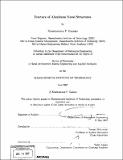Fracture of aluminum naval structures
Author(s)
Galanis, Konstantinos, 1970-
DownloadFull printable version (42.39Mb)
Other Contributors
Massachusetts Institute of Technology. Dept. of Mechanical Engineering.
Advisor
Tomasz Wierzbicki.
Terms of use
Metadata
Show full item recordAbstract
Structural catastrophic failure of naval vessels due to extreme loads such as underwater or air explosion, high velocity impact (torpedoes), or hydrodynamic loads (high speed vessels) is primarily caused by fracture. Traditionally, naval structures have been designed to resist yielding, buckling and fatigue, but not fracture. Consequently, adequate methods and procedures to design ships against fracture have not been developed. The rapidly increasing application of lightweight materials, such as aluminum alloys, in the shipbuilding industry requires fundamental understanding of mechanisms and mechanics of fracture that govern naval stiffened panels. Therefore, a comprehensive tool consisting of application of advanced fracture models, material calibration, and validation through component testing is provided that will increase the survivability envelope and speed up the development process of new vessels. Cracking is a major cause of structural degradation, which is a primary source of costly repair work on metal structures. This thesis studies the structural response of various stiffened plates and compares them with unstiffened plates represented by compact tension (CT) specimens. (cont.) An extensive experimental program is presented that includes coupon testing and small and intermediate scale tests on naval aluminum structures including a variety of monolithic T-type extruded and flatbar welded specimens. Representative naval designs are selected and subjected to quasi-static loading and a number of key parameters, such as geometry, loading rate and structural configuration are evaluated with respect to fracture. Numerical modeling and analyses of ductile fracture initiation and propagation on a pre-cracked geometry using a commercial finite element code (ABAQUS), taking into account the behavior of simple uncracked material, has been performed showing a very good agreement with small and intermediate scale tests. Two major contributions of this thesis are the mapping of crack patterns in stiffened plates and the development of a methodology which enables ship designers to evaluate critical areas within a structure with respect to crack initiation, propagation, optimum material usage, and computational cost.
Description
Thesis (Ph. D.)--Massachusetts Institute of Technology, Dept. of Mechanical Engineering, 2007. "June 2007." Includes bibliographical references (leaves 238-272).
Date issued
2007Department
Massachusetts Institute of Technology. Department of Mechanical EngineeringPublisher
Massachusetts Institute of Technology
Keywords
Mechanical Engineering.